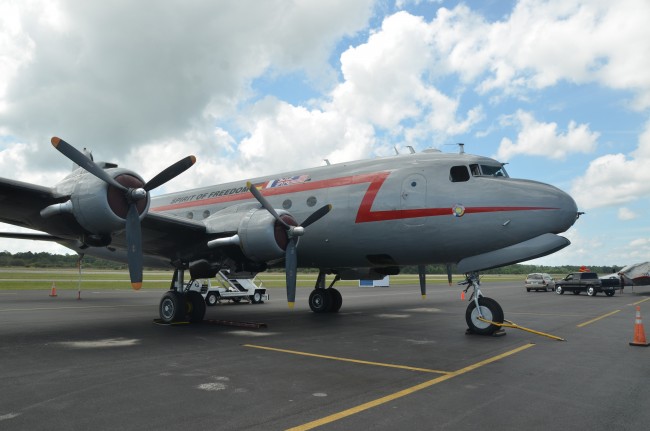
History rarely intersects this way, at least not in Palm Coast, where the oldest building is barely contemporary with the latter part of the Vietnam War. But this afternoon, there was James Kade, a 91-year-old Palm Coast resident and a World War II veteran of the Luftwaffe, the German air force, about to climb aboard the Spirit of Freedom, one of the 300-odd Douglas C-54 airplanes that took part in the Berlin Airlift of 1948-49, the most extensive humanitarian mission in history (until then or since).
Kade, a native of Latvia, had joined the Luftwaffe because Latvians despised Stalin’s Red Army even more than they despised the Nazis back then. Latvia had been conquered by the Red Army, and Kade was eager to liberate it. After the war he ended up in a refugee camp in the American sector of southwest Germany.
“I was working for an American Express man who was stationed in Stuttgart as his chauffeur,” Kade said this morning, “and we did a lot of trips to Frankfurt and all around. We were always going by the Frankfurt airport. I saw all the transport planes coming in and out, it was a constant stream of it. And I remember one plane was returning from berlin, and one of the engines was on fire, it was right over the airport. He got down all right. But I saw an awful lot of that traffic from the ground up.”
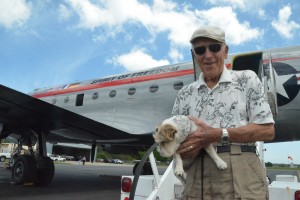
“It was a wonderful experience. I’ll never forget it,” Chopp says. “The Berliners that experienced the airlift, we had a line of people that would cover the length of a football field to get into the airplane to see it. And that was on May 12, 1998. That’s the date they celebrate the lifting of the blockade [on that date in 1949, after 328 days]. We opened out at 8 o’clock in the morning and didn’t close until midnight that night. The appreciation was awesome. A lot of tears. A lot of tears.”
That enormous hunk of history landed at the Flagler County Airport and will remain there through Sunday afternoon as part of the annual Wings Over Flagler Rockin the Runways fly-in, with free tours (once you get past the admission gate) all three days. On Wednesday, however, Chopp opened the flying museum to visitors, with a focus on Flagler County school children. Kelly Grillo, a literacy coach at Buddy Taylor Middle School who also serves on the board of Mills Aviation Charities—Bill and Kim Mills are the founders of Wings Over Flagler) sent out word through the schools that the museum would be open today. This being spring break, few children were in evidence (Two empty Flagler County school buses made an appearance on the tarmac, but only because the buses were being used to delineate the boundaries of the flying “envelope” where the air show’s aerobatic performances will take place.)
Still, several children did show up, among them David Telfer, 12, and his sister, Katie, 9. For David, it was the first time stepping on a plane at all. “My mom is afraid of heights,” he said. “She doesn’t like planes.” He’d just heard the stories of the airlift, the blockaded city, the rationed goods. “I’d hate that,” he said, imagining himself in berlin at the time, though there was always the occasional joyful moment, as when one of the C-54s’ most celebrated pilots, Gail Harlvorsen, would drop chewing gum or candy to children at the end of Templehof’s runways. Those drops are sometime reenacted by the Spirit of Freedom. (You can watch Chopp with Halvorsen, who’s now 94, in the video below.)
David’s sister Katie said she was “a bit surprised on how old” the C-54 looked, “but based on World War II, I’m not surprised.” To Ryan Little, an 11-year-old from Imagine School at Town Center, the attraction of the plane was calibrated in relation to his recent trip to New York on Jet Blue. The Spirt of Freedom, he said, has better leg room, as he demonstrates how cramped he was on the commercial flight.
It’s experiences like that that led Roy Sieger to become what he is today. As a young boy he’d grab a Coke and with his father, watch planes take off and land at the airport in Ocala. “Who knew one day I’d be in the Marine Corps, do 20 years in marine Corps aviation and end up being an airport director,” Sieger says. “You never know when that spark might go off.” For Chopp, it was reading a Life magazine full of images of what he thinks was the Berlin airlift, when he was about 6 years old.
Mary Telfer, who’d brought her grandchildren to the museum, was born the same year the C-054 was built: 1945. She has no recollections of the airlift. The one event she does remember that, very much like the Berlin blockade, brought the world to the brink of World War III, is the Cuban missile crisis—the sort of existential fears, she says, children today have neither experienced nor have any knowledge of, even with the goings on in the Middle East. She wasn’t sure how much, with the bombardments of television, the internet and other media these days, the children will remember of today’s lessons about the airlift. “They’ll remember the occasion, but I don’t know how much they’ll remember the details,” Telfer said.
Thirty-one American airmen and 39 British airmen lost their lives during the days and nights of the airlift as flights did not always make it through difficult weather conditions and the occasional mechanical failure.
For all the grandeur of the plane on the tarmac, and what it represents, the Berlin airlift simply doesn’t register much, if at all, in the American historical imagination, especially for those who never lived through those years. People these days want to see bombers, Chopp says. And they’ll get to do just that at Wings Over Flagler: a B-17 Flying Fortress is due here Thursday morning. Transport planes don’t have the same attraction, no matter how significant their place in history.
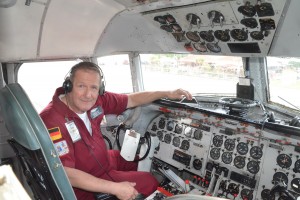
Chopp has been flying the Spirit of Freedom for 21 years, with some 1,500 hours of flying. The plane lifts off at 92 knots (about 110 mph) and cruises at 160 knots, burning 220 gallons of fuel and six gallons of oil every hour in the air (it carries 3,540 gallons of fuel). It doesn’t climb higher than 10,000 feet, because its cabin is not pressurized. “Whatever the temperature is outside is the temperature inside,” Starr says, though it’s not temperature that keeps the plane from flying in certain weather: it’s the need to keep the plane in good condition. Not subjecting it to harsh weather helps.
Chopp had been a corporate jet pilot, among other piloting gigs. He’d always been an avid lover of planes, especially transport planes, and history. “Putting all that together I felt an exhibit inside a C-54 would be a worthy cause.” In 1988, he created the Spirit of Freedom Foundation. It took him four years to find the plane. He bought it for $125,000, even though he just had $3,000 (money it took three years to raise). Between supporters, loans and luck, the transaction to buy the plane in Canada worked out when the plane owner—Ed Johns—a curmudgeonly sort who’d rubbed many prospective buyers the wrong way, softened toward Chopp the moment Chopp told him that his father had been wounded at the Battle of the Bulge at the end of the World War II. Johns had fought in that battle. The deal was sealed.
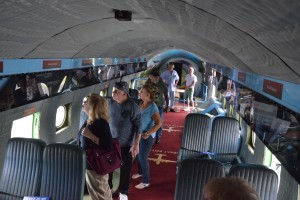
Of course compared to Kade, the former Luftwaffe airman, Chopp is quite a young man. Kade immigrated to the United States in 1949 and got his citizenship five years later. “I have been I hope a good American since. I haven’t missed an election,” Kade says. In the mid-90s he flew gliders out of Flagler County Airport, but he had to put a stop to it because “there were an awful lot of Embry-Riddle students flying in and out of here,” and they’d get all nervous, just as he would. But he’s still an airman. “Aviation lies in my heart,” he says, stepping up the air stairs to get onto the Spirit of Freedom.
Wings Over Flagler Rockin the Runways hours are from 4 to 9 p.m. Friday, 10 a.m. to 9 p.m. Saturday, and from 10 a.m. to 2 p.m. Sunday concluding with a massive fly-off. Parking and shuttle service is free, and $5 airport parking is offered. Many education charities benefit from the event. Admission is just $12 adults, veterans $10 and kids 12 and under $5. No pets or coolers. Bring concert chairs. For more aircraft information go to WingsOverFlagler.com.
![]()
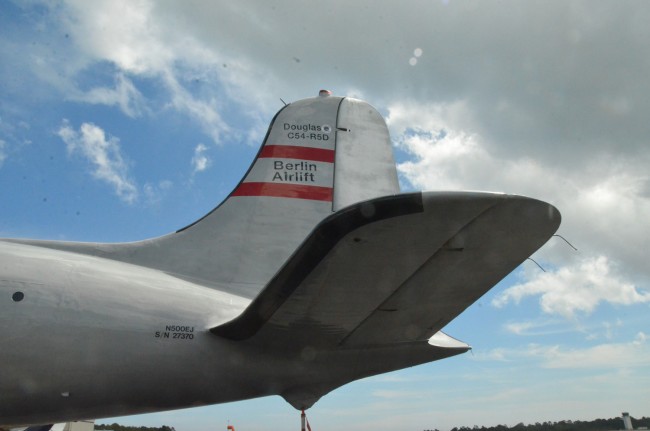





























Will (#1) says
The C-54 is a hardy workhorse. Back in 1970, while based with the Navy in Pensacola, I got to fly as a passenger on one of that fleet of Berlin airlifters a number of times across or around the country. The crew was good, so we didn’t worry much about small oil leaks streaming back on the engine cowlings…. The story was that that plane, and/or others like it, still had coal dust in some tight spaces left over from flying coal to Berlin. Quite a bird.